As U.S. inflation shows signs of slowing, Wall Street investors are increasingly turning to Bitcoin as a potential hedge against rising prices. With inflation easing to around 2.9%, cryptocurrencies like Bitcoin are gaining attention because of their limited supply and ability to preserve value over time. Market volatility remains, but digital assets are becoming a popular diversification tool during uncertain economic times. To explore how these trends could impact your investments, keep exploring further.
Key Takeaways
- Recent inflation slowdown has increased investor interest in Bitcoin as a potential hedge against inflation.
- Wall Street analysts see Bitcoin’s limited supply and rising adoption as advantages during inflationary periods.
- Digital assets like Bitcoin are gaining recognition for diversification and protection amid fluctuating traditional markets.
- Lower inflation rates may reduce pressure for aggressive rate hikes, influencing Bitcoin’s role as a safe haven.
- Market trends indicate growing confidence in Bitcoin’s long-term potential as an inflation hedge alongside gold.
Recent Trends in U.S. Inflation Rates
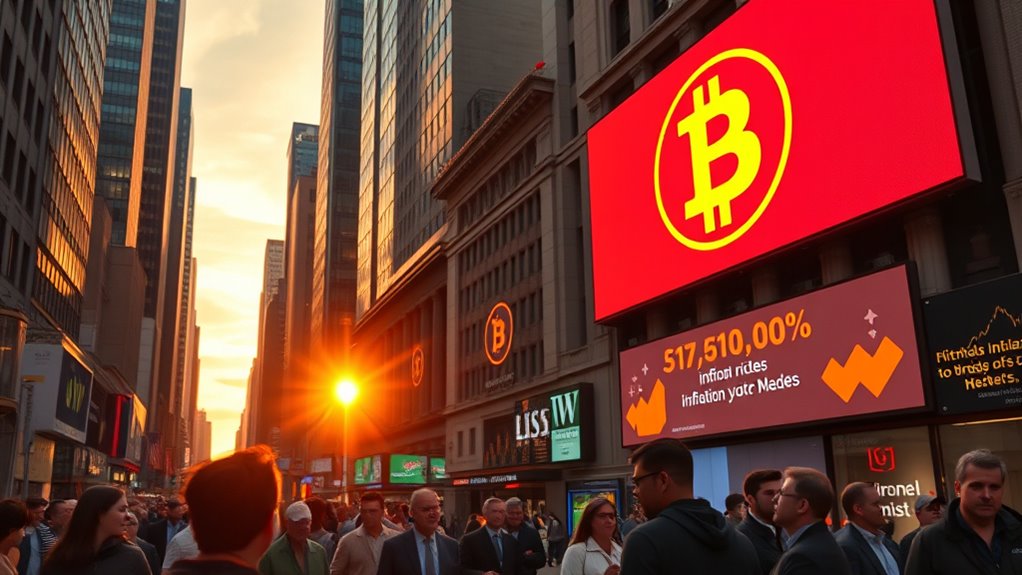
Recent trends in U.S. inflation rates show a gradual increase, with the annual inflation rate rising to 2.9% in August 2025 from 2.7% in July. You’ll notice the Consumer Price Index (CPI) grew by 0.4% in August, driven mainly by higher shelter and energy costs. Shelter costs increased by 0.4%, influencing overall price growth, while energy prices rose by 0.7%, with gasoline up 1.9%. Core inflation, which excludes volatile food and energy prices, reached 3.1%, indicating persistent underlying inflation. These figures suggest prices are rising steadily but not substantially. While inflation remains manageable, certain sectors like housing and energy contribute considerably to the upward trend. Cybersecurity vulnerabilities during this period underscore the importance of safeguarding financial information and digital assets. Monitoring these patterns helps you understand how inflation impacts your purchasing power and overall economy.
Factors Contributing to Inflation Dynamics
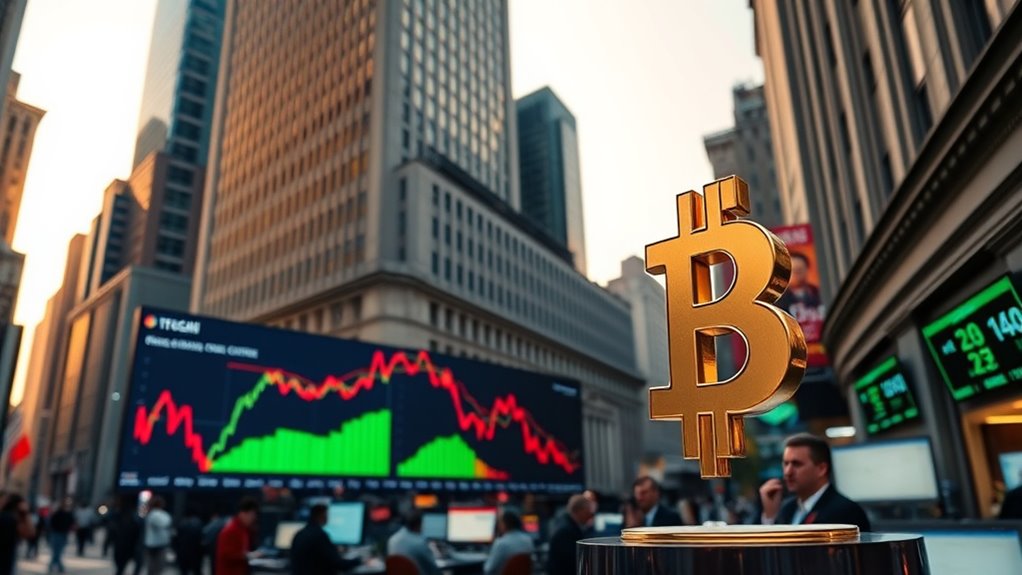
Several factors drive the ongoing inflation dynamics in the U.S., shaping how prices change over time. Rising energy prices, especially gasoline, contribute to higher transportation costs, which ripple through the economy. Shelter costs, including rent and home prices, continue to increase, adding to consumers’ expenses. Import tariffs and supply chain disruptions raise costs for imported goods, pushing prices upward. Food prices also climb due to weather events and agricultural pressures. Strong demand, driven by economic growth, fuels inflation as businesses raise prices to meet higher consumer spending. Additionally, wage increases and labor shortages can lead to higher service costs. Unique Beetroot Recipes and other health-conscious food trends influence consumer purchasing patterns, indirectly affecting inflation. These elements combine to influence overall inflation, creating a complex picture that impacts your purchasing power and investment decisions.
Market Reactions and Investor Sentiments
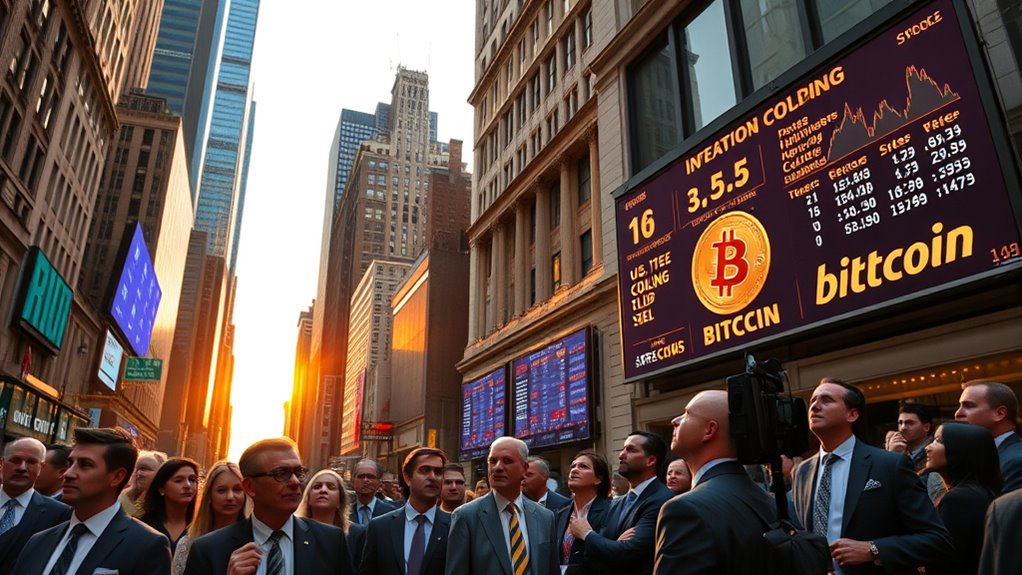
As inflation trends rise steadily, market reactions and investor sentiments become increasingly sensitive to economic data and policy signals. You notice that stocks may fluctuate as traders react to inflation reports, shifting their expectations for interest rate hikes or cuts. When inflation data suggests a potential slowdown, confidence can grow, prompting investors to seek higher-risk assets like equities. Conversely, signs of persistent or accelerating inflation often trigger caution, pushing money into safer assets such as gold or even Bitcoin. You observe that sentiment around digital assets is shifting; many see Bitcoin as a hedge, boosting its appeal amid inflation concerns. Overall, investor moods swing quickly based on new data, making markets more volatile and reaction-driven during this period. Additionally, the perception of Bitcoin as a 1st Home Theatre Projector emerging hedge is gaining traction among Wall Street investors looking to diversify their portfolios.
Bitcoin’s Growing Role as an Inflation Hedge

You might see Bitcoin as a strong hedge against inflation because of its limited supply, which helps protect its value when prices rise. However, its price swings can make it risky compared to traditional assets, so you should weigh the volatility challenges carefully. Still, many investors find that adding Bitcoin offers diversification benefits, especially during periods of rising inflation. Additionally, some investors consider asset diversification as a key reason for including cryptocurrencies like Bitcoin in their portfolios.
Limited Supply Advantage
Bitcoin’s limited supply gives it a distinct advantage as an inflation hedge, especially when traditional assets face rising prices. Unlike fiat currencies, which governments can print endlessly, Bitcoin’s supply is capped at 21 million coins. This scarcity means that, as inflation erodes the value of money, Bitcoin’s relative value can increase. You can see this as a built-in safeguard against currency devaluation. When inflation rises, the fixed supply acts as a counterbalance, preserving purchasing power over time. This contrasts with assets like cash or bonds, which lose value when prices climb. Because of its scarcity, Bitcoin offers an alternative store of value that isn’t directly affected by monetary policy or economic shocks in the same way as traditional assets. That’s why more investors view it as a potential hedge during inflationary periods. Additionally, its growing recognition as an AI security asset underscores its emerging role in diversified investment strategies.
Volatility Challenges Persist
Despite its growing reputation as an inflation hedge, Bitcoin continues to face significant volatility that challenges its reliability. Price swings can be dramatic, often driven by market sentiment, regulatory news, or macroeconomic factors. This volatility makes it risky for investors seeking stable protection against inflation, especially during uncertain economic times. While Bitcoin’s limited supply and decentralization appeal, its unpredictable price movements can undermine its role as a safe haven. Investors must carefully weigh these risks against potential benefits. Even as more people consider Bitcoin as part of their inflation strategy, the asset’s erratic behavior remains a barrier for many. Until volatility stabilizes, Bitcoin’s status as a dependable inflation hedge will continue to face scrutiny. Additionally, the age of the asset can influence its market stability and investor confidence.
Diversification Benefits
As inflation risks rise, investors increasingly see Bitcoin as a valuable addition to diversified portfolios. Its limited supply and decentralized nature make it an attractive hedge against currency devaluation and inflation. Unlike traditional assets, Bitcoin isn’t tied to any government or central bank, reducing exposure to monetary policy risks. Including Bitcoin can help balance a portfolio exposed to inflation, potentially preserving purchasing power during economic shocks. Its low correlation with stocks and bonds adds a layer of diversification, especially when inflation causes volatility in conventional assets. Additionally, the growing acceptance and integration of Bitcoin into mainstream financial systems enhance its stability as an inflation hedge. However, keep in mind Bitcoin’s price can be volatile, so it’s best used as part of a broader strategy. Overall, adding Bitcoin enhances your portfolio’s resilience against inflation, giving you more control over long-term growth.
Comparing Traditional and Digital Asset Safeguards
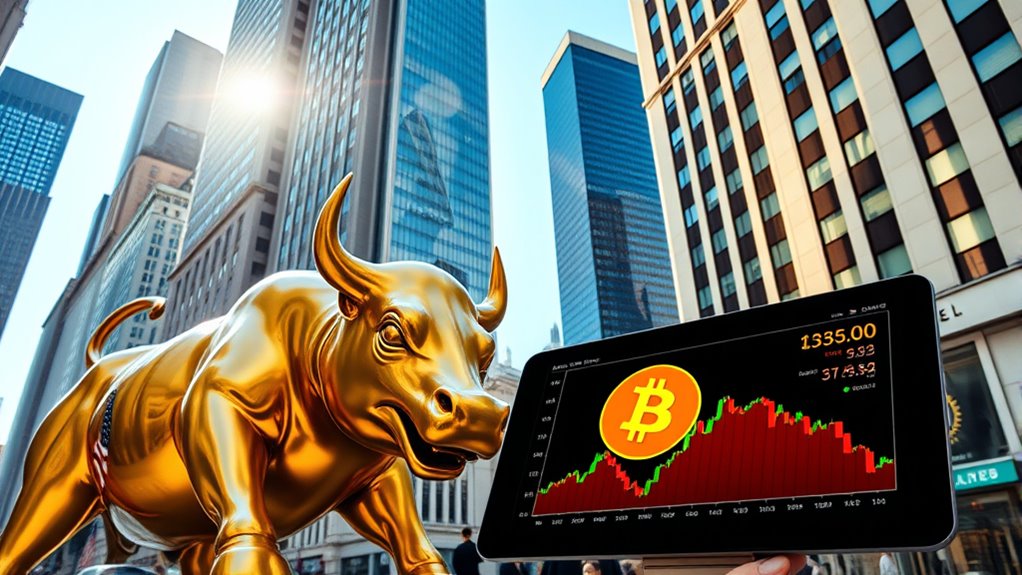
Traditional asset safeguards, such as banks, government-backed insurance, and regulatory frameworks, depend on established institutions to protect your investments and guarantee stability. These safeguards rely on legal structures, oversight, and the backing of governments to mitigate risks like bank failures or fraud. They offer a sense of security through insured deposits and strict compliance standards. In contrast, digital assets like Bitcoin operate outside these traditional protections. They rely on cryptography, decentralized networks, and code to secure transactions and holdings. While digital assets aren’t insured or regulated in the same way, they provide transparency and control directly to you, without intermediaries. Each approach has strengths and weaknesses, with traditional safeguards emphasizing stability and regulation, and digital assets prioritizing autonomy and resilience against institutional failures. Vetted – Mother Baby Kids
Economic Indicators and Future Outlook

You should pay attention to recent economic indicators, which suggest inflation may stabilize or slightly cool in the coming months. Cryptocurrency market trends also indicate increasing interest in digital assets as potential inflation hedges. Together, these signals help shape expectations for the economy’s future and Bitcoin’s role within it. Additionally, AI-driven platforms are increasingly being used to analyze market data, providing more sophisticated insights for investors. AI-driven platforms
Inflation Forecast Stability
Recent economic indicators suggest that the U.S. inflation forecast is relatively stable, with key metrics pointing toward a muted change in prices over the coming months. The CPI nowcast for October 2025 stands at 0.19%, indicating a potential slowdown in inflation. Core CPI nowcast is at 0.25%, showing steady core price movements. Projections for quarterly inflation remain close, with estimates around 3.20-3.23% for Q3 and Q4 2025. The annual inflation rate is expected to hover near 2.9% in August, with core inflation trending downward toward 2.30% by 2027. These signs suggest that inflation remains manageable, supported by moderate increases in shelter and energy costs. Additionally, the stability in inflation expectations can influence consumer confidence and spending behavior. Overall, economic indicators point to a stable outlook, reducing the likelihood of rapid price surges in the near term.
Cryptocurrency Market Trends
The cryptocurrency market is experiencing steady growth, driven by increasing investor interest in digital assets as alternative investments and potential hedges against inflation. You see more traders viewing Bitcoin and other cryptocurrencies as ways to diversify portfolios and protect wealth from inflationary pressures. Market trends indicate rising adoption and institutional involvement, despite notable volatility. As inflation shows signs of cooling, some investors remain cautious but optimistic about digital assets’ long-term potential. Here’s a snapshot of current ideas:
| Aspect | Insights |
|---|---|
| Market Growth | Steady, driven by increased interest |
| Investor Sentiment | Growing, with focus on hedging |
| Volatility | Present, but declining over time |
This suggests a shifting landscape where cryptocurrencies could become key inflation hedges.
Implications for Investors and Policy Makers
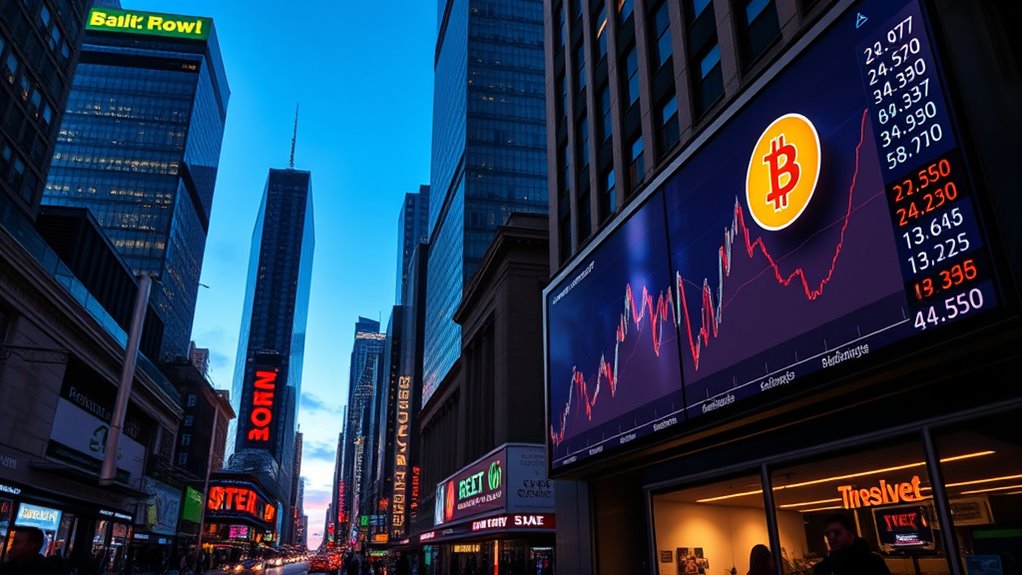
As inflation continues to hover around moderate levels, investors and policymakers must carefully adjust their strategies to safeguard economic stability and growth. You should consider diversifying portfolios to include assets like Bitcoin, which is increasingly viewed as a hedge against inflation’s erosion of purchasing power. However, be mindful of Bitcoin’s volatility and risks. Policymakers need to balance interest rate adjustments, ensuring they don’t stifle growth while preventing inflation from rising too quickly. Maintaining transparent communication and flexible policies will help anchor inflation expectations. For investors, staying informed about inflation trends and alternative assets like gold or real estate remains vital. Ultimately, a proactive, well-informed approach will help navigate the evolving economic landscape effectively.
Frequently Asked Questions
How Might Upcoming Monetary Policy Changes Impact Inflation Trends?
You should expect that upcoming monetary policy changes, like interest rate adjustments, will directly influence inflation trends. If the Federal Reserve raises rates, borrowing becomes more expensive, which can slow spending and help curb inflation. Conversely, lowering rates might stimulate growth but risk increasing inflation. Staying aware of these policy shifts helps you anticipate how inflation could evolve, impacting your savings, investments, and purchasing power.
What Are the Long-Term Risks of Investing in Bitcoin as a Hedge?
Investing in Bitcoin as a hedge carries risks that could shake your confidence to the core. Its volatility makes it feel like riding a roller coaster with no safety bars—one moment soaring, the next plummeting. You might lose a significant chunk of your investment overnight. Over the long term, unpredictable regulatory crackdowns and market manipulation threaten to turn your secure hedge into a financial nightmare. Proceed with caution; the risks are colossal.
How Do Global Economic Shifts Influence U.S. Inflation Rates?
Global economic shifts, like changes in trade policies, commodity prices, and currency fluctuations, directly impact U.S. inflation rates. When global demand rises or supply chains face disruptions, prices for goods and energy may increase, fueling inflation. Conversely, economic slowdowns abroad can reduce demand and help cool inflation. You should stay aware of these shifts, as they can cause fluctuations in inflation, affecting your investments and purchasing power.
Will Inflation Continue to Cool in the Next Year?
Yes, inflation is likely to continue cooling over the next year. You can expect the CPI to stabilize as supply chain issues improve and energy prices gently decline. While core inflation may stay around 2.3% to 2.6%, ongoing monetary policies and the global economic environment will influence this trend. Keep an eye on inflation indicators like the PCE and CPI nowcasts, which suggest a gradual easing in price pressures.
How Do Traditional Assets Compare to Cryptocurrencies in Inflation Protection?
Traditional assets like gold and real estate are often the steady ships in stormy waters, providing reliable inflation protection. Cryptocurrencies, especially Bitcoin, are more like lightning bolts—volatile but potentially offering higher returns during inflation. You should weigh the stability of traditional assets against the growth potential of digital currencies. Diversifying your portfolio could help you navigate inflation’s unpredictable waves more effectively.
Conclusion
As inflation cools, you can see Bitcoin rising as a beacon in turbulent waters, offering a fresh hedge against economic uncertainty. While traditional assets still play a role, digital currencies are carving out their place, like new stars in the financial sky. Stay alert and adaptable—this evolving landscape might just turn the tide in your favor, turning market storms into opportunities for savvy investors willing to embrace the future of finance.








